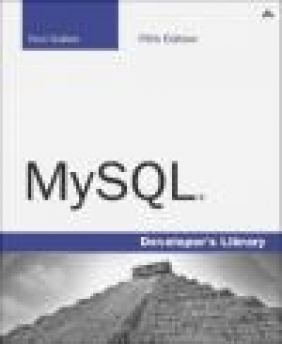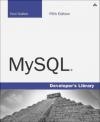MySQL
Paul DuBois
MySQL
Paul DuBois
- Producent: Addison Wesley Publishing Company
- Rok produkcji: 2013
- ISBN: 9780321833877
- Ilość stron: 1176
- Oprawa: Miękka
Niedostępna
Opis: MySQL - Paul DuBois
MySQL, Fifth Edition by Paul DuBois The definitive guide to using, programming and administering MySQL 5.5 and MySQL 5.6 MySQL provides a comprehensive guide to effectively using and administering the MySQL database management system (DBMS). Author Paul DuBois describes everything from the basics of getting information into a database and formulating queries, to using MySQL with PHP or Perl to generate dynamic web pages, to writing your own programs that access MySQL databases, to administering MySQL servers. The book also includes a comprehensive reference section providing detailed information on MySQL's structure, language, syntax, and APIs. The fifth edition of this bestselling book has been meticulously revised and updated to thoroughly cover the latest features and capabilities of MySQL 5.5, as well as to add new coverage of features introduced with MySQL 5.6. MySQL is an open source relational database management system (DBMS) that has experienced a phenomenal growth in popularity and use. Known for its speed and ease of use, MySQL has proven itself to be particularly well-suited for developing database-backed websites and applications. MySQL runs on anything from modest hardware all the way up to enterprise servers, and its performance rivals any database system put up against it. Paul DuBois' MySQL, Fifth Edition, is the definitive guide to fully exploiting all the power and versatility of MySQL 5.5 and MySQL 5.6 Contents at a Glance Part I: General MySQL Use Chapter 1 Getting Started with MySQL Chapter 2 Using SQL to Manage Data Chapter 3 Data Types Chapter 4 Views and Stored Programs Chapter 5 Query Optimization Part II: Using MySQL Programming Interfaces Chapter 6 Introduction to MySQL Programming Chapter 7 Writing MySQL Programs Using C Chapter 8 Writing MySQL Programs Using Perl DBI Chapter 9 Writing MySQL Programs Using PHP Part III: MySQL Administration Chapter 10 Introduction to MySQL Administration Chapter 11 The MySQL Data Directory Chapter 12 General MySQL Administration Chapter 13 Security and Access Control Chapter 14 Database Maintenance, Backups, and Replication Part IV: Appendixes Appendix A Software Required to Use This Book Appendix B Data Type Reference Appendix C Operator and Function Reference Appendix D System, Status, and User Variable Reference Appendix E SQL Syntax Reference Appendix F MySQL Program Reference Online Appendixes: Appendix G C API ReferenceAppendix H Perl DBI API Reference Appendix I PHP API ReferenceIntroduction Part I: General MySQL Use Chapter 1 Getting Started with MySQL 1.1 How MySQL Can Help You 1.2 A Sample Database 1.2.1 The U.S. Historical League Project 1.2.2 The Grade-Keeping Project 1.2.3 How the Sample Database Applies to You 1.3 Basic Database Terminology 1.3.1 Structural Terminology 1.3.2 Query Language Terminology 1.3.3 MySQL Architectural Terminology 1.4 A MySQL Tutorial 1.4.1 Obtaining the Sample Database Distribution 1.4.2 Preliminary Requirements 1.4.3 Establishing and Terminating Connections to the MySQL Server 1.4.4 Executing SQL Statements 1.4.5 Creating a Database 1.4.6 Creating Tables 1.4.7 Adding New Rows 1.4.8 Resetting the sampdb Database to a Known State 1.4.9 Retrieving Information 1.4.10 Deleting or Updating Existing Rows 1.5 Tips for Interacting with mysql 1.5.1 Simplifying the Connection Process 1.5.2 Issuing Statements with Less Typing 1.6 Where to Now? Chapter 2 Using SQL to Manage Data 2.1 The Server SQL Mode 2.2 MySQL Identifier Syntax and Naming Rules 2.3 Case Sensitivity in SQL Statements 2.4 Character Set Support 2.4.1 Specifying Character Sets 2.4.2 Determining Character Set Availability and Current Settings 2.4.3 Unicode Support 2.5 Selecting, Creating, Dropping, and Altering Databases 2.5.1 Selecting Databases 2.5.2 Creating Databases 2.5.3 Dropping Databases 2.5.4 Altering Databases 2.6 Creating, Dropping, Indexing, and Altering Tables 2.6.1 Storage Engine Characteristics 2.6.2 Creating Tables 2.6.3 Dropping Tables 2.6.4 Indexing Tables 2.6.5 Altering Table Structure 2.7 Obtaining Database Metadata 2.7.1 Obtaining Metadata with SHOW 2.7.2 Obtaining Metadata with INFORMATION_SCHEMA 2.7.3 Obtaining Metadata from the Command Line 2.8 Performing Multiple-Table Retrievals with Joins 2.8.1 Inner Joins 2.8.2 Qualifying References to Columns from Joined Tables 2.8.3 Left and Right (Outer) Joins 2.9 Performing Multiple-Table Retrievals with Subqueries 2.9.1 Subqueries with Relative Comparison Operators 2.9.2 IN and NOT IN Subqueries 2.9.3 ALL, ANY, and SOME Subqueries 2.9.4 EXISTS and NOT EXISTS Subqueries 2.9.5 Correlated Subqueries 2.9.6 Subqueries in the FROM Clause 2.9.7 Rewriting Subqueries as Joins 2.10 Performing Multiple-Table Retrievals with UNION 2.11 Multiple-Table Deletes and Updates 2.12 Performing Transactions 2.12.1 Using Transactions to Ensure Safe Statement Execution 2.12.2 Using Transaction Savepoints 2.12.3 Transaction Isolation 2.13 Foreign Keys and Referential Integrity 2.14 Using FULLTEXT Searches 2.14.1 Natural Language FULLTEXT Searches 2.14.2 Boolean Mode FULLTEXT Searches 2.14.3 Query Expansion FULLTEXT Searches 2.14.4 Configuring the FULLTEXT Search Engine Chapter 3 Data Types 3.1 Data Value Categories 3.1.1 Numeric Values 3.1.2 String Values 3.1.3 Temporal (Date and Time) Values 3.1.4 Spatial Values 3.1.5 Boolean Values 3.1.6 The NULL Value 3.2 MySQL Data Types 3.2.1 Data Type Overview 3.2.2 Specifying Column Types in Table Definitions 3.2.3 Specifying Column Default Values 3.2.4 Numeric Data Types 3.2.5 String Data Types 3.2.6 Temporal (Date and Time) Data Types 3.3 How MySQL Handles Invalid Data Values 3.4 Working with Sequences 3.4.1 General AUTO_INCREMENT Properties 3.4.2 Storage Engine-Specific AUTO_INCREMENT Properties 3.4.3 Issues to Consider with AUTO_INCREMENT Columns 3.4.4 Tips for Working with AUTO_INCREMENT Columns 3.4.5 Generating Sequences Without AUTO_INCREMENT 3.5 Expression Evaluation and Type Conversion 3.5.1 Writing Expressions 3.5.2 Type Conversion 3.6 Choosing Data Types 3.6.1 What Kind of Values Will the Column Hold? 3.6.2 Do Your Values Lie Within Some Particular Range? Chapter 4 Views and Stored Programs 4.1 Using Views 4.2 Using Stored Programs 4.2.1 Compound Statements and Statement Delimiters 4.2.2 Stored Functions and Procedures 4.2.3 Triggers 4.2.4 Events 4.3 Security for Views and Stored Programs Chapter 5 Query Optimization 5.1 Using Indexing 5.1.1 Benefits of Indexing 5.1.2 Costs of Indexing 5.1.3 Choosing Indexes 5.2 The MySQL Query Optimizer 5.2.1 How the Optimizer Works 5.2.2 Using EXPLAIN to Check Optimizer Operation 5.3 Choosing Data Types for Efficient Queries 5.4 Choosing Table Storage Formats for Efficient Queries 5.5 Loading Data Efficiently 5.6 Scheduling, Locking, and Concurrency Part II: Using MySQL Programming Interfaces Chapter 6 Introduction to MySQL Programming 6.1 Why Write Your Own MySQL Programs? 6.2 APIs Available for MySQL 6.2.1 The C API 6.2.2 The Perl DBI API 6.2.3 The PHP API 6.3 Choosing an API 6.3.1 Execution Environment 6.3.2 Performance 6.3.3 Development Time 6.3.4 Portability Chapter 7 Writing MySQL Programs Using C 7.1 Compiling and Linking Client Programs 7.2 Connecting to the Server 7.3 Handling Errors and Processing Command Options 7.3.1 Checking for Errors 7.3.2 Getting Connection Parameters at Runtime 7.3.3 Incorporating Option Processing into a Client Program 7.4 Processing SQL Statements 7.4.1 Handling Statements That Modify Rows 7.4.2 Handling Statements That Return a Result Set 7.4.3 A General-Purpose Statement Handler 7.4.4 Alternative Approaches to Statement Processing 7.4.5 mysql_store_result() Versus mysql_use_result() 7.4.6 Using Result Set Metadata 7.4.7 Encoding Special Characters and Binary Data 7.5 An Interactive Statement-Execution Program 7.6 Writing Clients That Include SSL Support 7.7 Using Multiple-Statement Execution 7.8 Using Server-Side Prepared Statements 7.9 Using Prepared CALL Support Chapter 8 Writing MySQL Programs Using Perl DBI 8.1 Perl Script Characteristics 8.2 Perl DBI Overview 8.2.1 DBI Data Types 8.2.2 A Simple DBI Script 8.2.3 Handling Errors 8.2.4 Handling Statements That Modify Rows 8.2.5 Handling Statements That Return a Result Set 8.2.6 Quoting Special Characters in Statement Strings 8.2.7 Placeholders and Prepared Statements 8.2.8 Binding Query Results to Script Variables 8.2.9 Specifying Connection Parameters 8.2.10 Debugging 8.2.11 Using Result Set Metadata 8.2.12 Performing Transactions 8.3 Putting DBI to Work 8.3.1 Generating the Historical League Directory 8.3.2 Sending Membership Renewal Notices 8.3.3 Historical League Member Entry Editing 8.3.4 Finding Historical League Members with Common Interests 8.3.5 Putting the Historical League Directory Online 8.4 Using DBI in Web Applications 8.4.1 Setting Up Apache for CGI Scripts 8.4.2 A Brief CGI.pm Primer 8.4.3 Connecting to the MySQL Server from Web Scripts 8.4.4 A Web-Based Database Browser 8.4.5 A Grade-Keeping Project Score Browser 8.4.6 Historical League Common-Interest Searching Chapter 9 Writing MySQL Programs Using PHP 9.1 PHP Overview 9.1.1 A Simple PHP Script 9.1.2 Using PHP Library Files for Code Encapsulation 9.1.3 A Simple Data-Retrieval Page 9.1.4 Processing Statement Results 9.1.5 Testing for NULL Values in Query Results 9.1.6 Using Prepared Statements 9.1.7 Using Placeholders to Handle Data Quoting Issues 9.1.8 Handling Errors 9.2 Putting PHP to Work 9.2.1 An Online Score-Entry Application 9.2.2 Creating an Interactive Online Quiz 9.2.3 Historical League Online Member Entry Editing Part III: MySQL Administration Chapter 10 Introduction to MySQL Administration 10.1 MySQL Components 10.2 General MySQL Administration 10.3 Access Control and Security 10.4 Database Maintenance, Backups, and Replication Chapter 11 The MySQL Data Directory 11.1 The Data Directory Location 11.2 Structure of the Data Directory 11.2.1 How the MySQL Server Provides Access to Data 11.2.2 Representation of Databases in the Filesystem 11.2.3 Representation of Tables in the Filesystem 11.2.4 Representation of Views and Triggers in the Filesystem 11.2.5 How SQL Statements Map onto Table File Operations 11.2.6 Operating System Constraints on Database Object Names 11.2.7 Factors That Affect Maximum Table Size 11.2.8 Implications of Data Directory Structure for System Performance 11.2.9 MySQL Status and Log Files 11.3 Relocating Data Directory Contents 11.3.1 Relocation Methods 11.3.2 Relocation Precautions 11.3.3 Assessing the Effect of Relocation 11.3.4 Relocating the Entire Data Directory 11.3.5 Relocating Individual Databases 11.3.6 Relocating Individual Tables 11.3.7 Relocating the InnoDB System Tablespace 11.3.8 Relocating Status and Log Files Chapter 12 General MySQL Administration 12.1 Securing a New MySQL Installation 12.1.1 Establishing Passwords for the Initial MySQL Accounts 12.1.2 Setting Up Passwords for Additional Servers 12.2 Arranging for MySQL Server Startup and Shutdown 12.2.1 Running the MySQL Server On Unix 12.2.2 Running the MySQL Server On Windows 12.2.3 Specifying Server Startup Options 12.2.4 Controlling How the Server Listens for Connections 12.2.5 Stopping the Server 12.2.6 Regaining Control of the Server When You Cannot Connect to It 12.3 Using System and Status Variables 12.3.1 Checking and Setting System Variable Values 12.3.2 Checking Status Variable Values 12.4 The Plugin Interface 12.5 Storage Engine Configuration 12.5.1 Selecting Storage Engines 12.5.2 Selecting a Default Storage Engine 12.5.3 Configuring the InnoDB Storage Engine 12.6 Globalization Issues 12.6.1 Configuring Time Zone Support 12.6.2 Selecting the Default Character Set and Collation 12.6.3 Selecting the Language for Error Messages 12.6.4 Selecting the Locale 12.7 Server Tuning 12.7.1 General-Purpose System Variables for Server Tuning 12.7.2 Storage Engine Tuning 12.7.3 Using the Query Cache 12.7.4 Hardware Optimizations 12.8 Server Logs 12.8.1 The Error Log 12.8.2 The General Query Log 12.8.3 The Slow Query Log 12.8.4 The Binary Log 12.8.5 The Relay Log 12.8.6 Using Log Tables 12.8.7 Log Management 12.9 Running Multiple Servers 12.9.1 General Multiple Server Issues 12.9.2 Configuring and Compiling Different Servers 12.9.3 Strategies for Specifying Startup Options 12.9.4 Using mysqld_multi for Server Management 12.9.5 Running Multiple Servers on Windows 12.9.6 Running Clients of Multiple Servers 12.10 Updating MySQL Chapter 13 Security and Access Control 13.1 Securing Filesystem Access to MySQL 13.1.1 How to Steal Data 13.1.2 Securing Your MySQL Installation 13.2 Managing MySQL User Accounts 13.2.1 High-Level MySQL Account Management 13.2.2 Granting Privileges 13.2.3 Displaying Account Privileges 13.2.4 Revoking Privileges 13.2.5 Changing Passwords or Resetting Lost Passwords 13.2.6 Avoiding Access-Control Risks 13.2.7 Pluggable Authentication and Proxy Users 13.3 Grant Table Structure and Contents 13.3.1 Grant Table Scope-of-Access Columns 13.3.2 Grant Table Privilege Columns 13.3.3 Grant Table Authentication Columns 13.3.4 Grant Table SSL-Related Columns 13.3.5 Grant Table Resource Management Columns 13.4 How the Server Controls Client Access 13.4.1 Scope Column Contents 13.4.2 Statement Access Verification 13.4.3 Scope Column Matching Order 13.4.4 A Privilege Puzzle 13.5 Setting Up Secure Connections Using SSL Chapter 14 Database Maintenance, Backups, and Replication 14.1 Principles of Preventive Maintenance 14.2 Performing Database Maintenance with the Server Running 14.2.1 Locking Individual Tables for Read-Only or Read/Write Access 14.2.2 Locking All Databases for Read-Only Access 14.3 General Preventive Maintenance 14.3.1 Using the Server's Auto-Recovery Capabilities 14.3.2 Scheduling Preventive Maintenance 14.4 Making Database Backups 14.4.1 Storage Engine Portability Characteristics 14.4.2 Making Text Backups with mysqldump 14.4.3 Making Binary Database Backups 14.4.4 Backing Up InnoDB Tables 14.5 Copying Databases to Another Server 14.5.1 Copying Databases Using a Backup File 14.5.2 Copying Databases from One Server to Another 14.6 Checking and Repairing Database Tables 14.6.1 Checking Tables with CHECK TABLE 14.6.2 Repairing Tables with REPAIR TABLE 14.6.3 Using mysqlcheck to Check and Repair Tables 14.7 Using Backups for Data Recovery 14.7.1 Recovering Entire Databases 14.7.2 Recovering Individual Tables 14.7.3 Re-Executing Statements in Binary Log Files 14.7.4 Coping with InnoDB Auto-Recovery Problems 14.8 Setting Up Replication Servers 14.8.1 How Replication Works 14.8.2 Establishing a Master-Slave Replication Relationship 14.8.3 Binary Logging Formats 14.8.4 Using a Replication Slave for Making Backups Part IV: Appendixes Note: Appendixes G, H, and I are located online and are accessible either by registering this book at informit.com/register or visiting www.kitebird.com/mysql-book Appendix A Software Required to Use This Book A.1 Obtaining the sampdb Sample Database Distribution A.2 Obtaining MySQL and Related Software A.3 MySQL Installation Notes A.3.1 Creating a Login Account for the MySQL User A.3.2 Installing MySQL A.3.3 Setting Your PATH Environment Variable A.3.4 Initializing the Data Directory and Grant Tables A.3.5 Starting the Server A.3.6 Initializing Other System Tables A.4 Perl DBI Installation Notes A.5 PHP and PDO Installation Notes Appendix B Data Type Reference B.1 Numeric Types B.1.1 Integer Types B.1.2 Fixed-Point Types B.1.3 Floating-Point Types B.1.4 BIT Type B.2 String Types B.2.1 Binary String Types B.2.2 Nonbinary String Types B.2.3 ENUM and SET Types B.3 Temporal (Date and Time) Types Appendix C Operator and Function Reference C.1 Operators C.1.1 Operator Precedence C.1.2 Grouping Operators C.1.3 Arithmetic Operators C.1.4 Comparison Operators C.1.5 Bit Operators C.1.6 Logical Operators C.1.7 Cast Operators C.1.8 Pattern-Matching Operators C.2 Functions C.2.1 Comparison Functions C.2.2 Cast Functions C.2.3 Numeric Functions C.2.4 String Functions C.2.5 Date and Time Functions C.2.6 Summary Functions C.2.7 Security and Compression Functions C.2.8 Advisory Locking Functions C.2.9 IP Address Functions C.2.10 XML Functions C.2.11 Spatial Functions C.2.12 Miscellaneous Functions Appendix D System, Status, and User Variable Reference D.1 System Variables D.1.1 InnoDB System Variables D.2 Status Variables D.2.1 InnoDB Status Variables D.2.2 Query Cache Status Variables D.2.3 SSL Status Variables D.3 User-Defined Variables Appendix E SQL Syntax Reference E.1 SQL Statement Syntax (Noncompound Statements) E.2 SQL Statement Syntax (Compound Statements) E.2.1 Control Structure Statements E.2.2 Declaration Statements E.2.3 Cursor Statements E.2.4 Condition-Handling Statements E.3 Comment Syntax Appendix F MySQL Program Reference F.1 Displaying a Program's Help Message F.2 Specifying Program Options F.2.1 Standard MySQL Program Options F.2.2 Option Files F.2.3 Environment Variables F.3 myisamchk F.3.1 Standard Options Supported by myisamchk F.3.2 Options Specific to myisamchk F.3.3 Variables for myisamchk F.4 mysql F.4.1 Standard Options Supported by mysql F.4.2 Options Specific to mysql F.4.3 Variables for mysql F.4.4 mysql Commands F.4.5 mysql Prompt Definition Sequences F.5 mysql.server F.5.1 Options Supported by mysql.server F.6 mysql_config F.6.1 Options Specific to mysql_config F.7 mysql_install_db F.7.1 Standard Options Supported by mysql_install_db F.7.2 Options Specific to mysql_install_db F.8 mysql_upgrade F.8.1 Standard Options Supported by mysql_upgrade F.8.2 Options Specific to mysql_upgrade F.9 mysqladmin F.9.1 Standard Options Supported by mysqladmin F.9.2 Options Specific to mysqladmin F.9.3 Variables for mysqladmin F.9.4 mysqladmin Commands F.10 mysqlbinlog F.10.1 Standard Options Supported by mysqlbinlog F.10.2 Options Specific to mysqlbinlog F.10.3 Variables for mysqlbinlog F.11 mysqlcheck F.11.1 Standard Options Supported by mysqlcheck F.11.2 Options Specific to mysqlcheck F.12 mysqld 1 F.12.1 Standard Options Supported by mysqld F.12.2 Options Specific to mysqld F.12.3 Variables for mysqld F.13 mysqld_multi F.13.1 Standard Options Supported by mysqld_multi F.13.2 Options Specific to mysqld_multi F.14 mysqld_safe F.14.1 Standard Options Supported by mysqld_safe F.14.2 Options Specific to mysqld_safe F.15 mysqldump F.15.1 Standard Options Supported by mysqldump F.15.2 Options Specific to mysqldump F.15.3 Data Format Options for mysqldump F.15.4 Variables for mysqldump F.16 mysqlimport F.16.2 Options Specific to mysqlimport F.16.3 Data Format Options for mysqlimport F.17 mysqlshow F.17.1 Standard Options Supported by mysqlshow F.17.2 Options Specific to mysqlshow F.18 perror F.18.1 Standard Options Supported by perror Appendix G C API Reference (Online Only) G.1 Compiling and Linking G.2 C API Data Structures G.2.1 Scalar Data Types G.2.2 Nonscalar Data Structures G.2.3 Accessor Macros G.3 C API Functions G.3.1 Client Library Initialization and Termination Routines G.3.2 Connection Management Routines G.3.3 Error-Reporting Routines G.3.4 Statement Construction and Execution Routines G.3.5 Result Set Processing Routines G.3.6 Multiple Result Set Routines G.3.7 Information Routines G.3.8 Transaction Control Routines G.3.9 Prepared Statement Routines G.3.10 Administrative Routines G.3.11 Threaded Client Routines G.3.12 Debugging Routines Appendix H Perl DBI API Reference (Online Only) H.1 Writing Scripts H.2 DBI Methods H.2.1 DBI Class Methods H.2.2 Database-Handle Methods H.2.3 Statement-Handle Methods H.2.4 General Handle Methods H.2.5 MySQL-Specific Administrative Methods H.3 DBI Utility Functions H.4 DBI Attributes H.4.1 Database-Handle Attributes H.4.2 General Handle Attributes H.4.3 MySQL-Specific Database-Handle Attributes H.4.4 Statement-Handle Attributes H.4.5 MySQL-Specific Statement-Handle Attributes H.4.6 Dynamic Attributes H.5 DBI Environment Variables Appendix I PHP API Reference (Online Only) I.1 Writing PHP Scripts I.2 PDO Classes I.3 PDO Methods I.3.1 PDO Class Methods I.3.2 PDOStatement Object Methods I.3.3 PDOException Object Methods I.3.4 PDO Constants Note: Appendixes G, H, and I are located online and are accessible either by registering this book at informit.com/register or visiting www.kitebird.com/mysql-book
Szczegóły: MySQL - Paul DuBois
Tytuł: MySQL
Autor: Paul DuBois
Producent: Addison Wesley Publishing Company
ISBN: 9780321833877
Rok produkcji: 2013
Ilość stron: 1176
Oprawa: Miękka
Waga: 1.77 kg






























